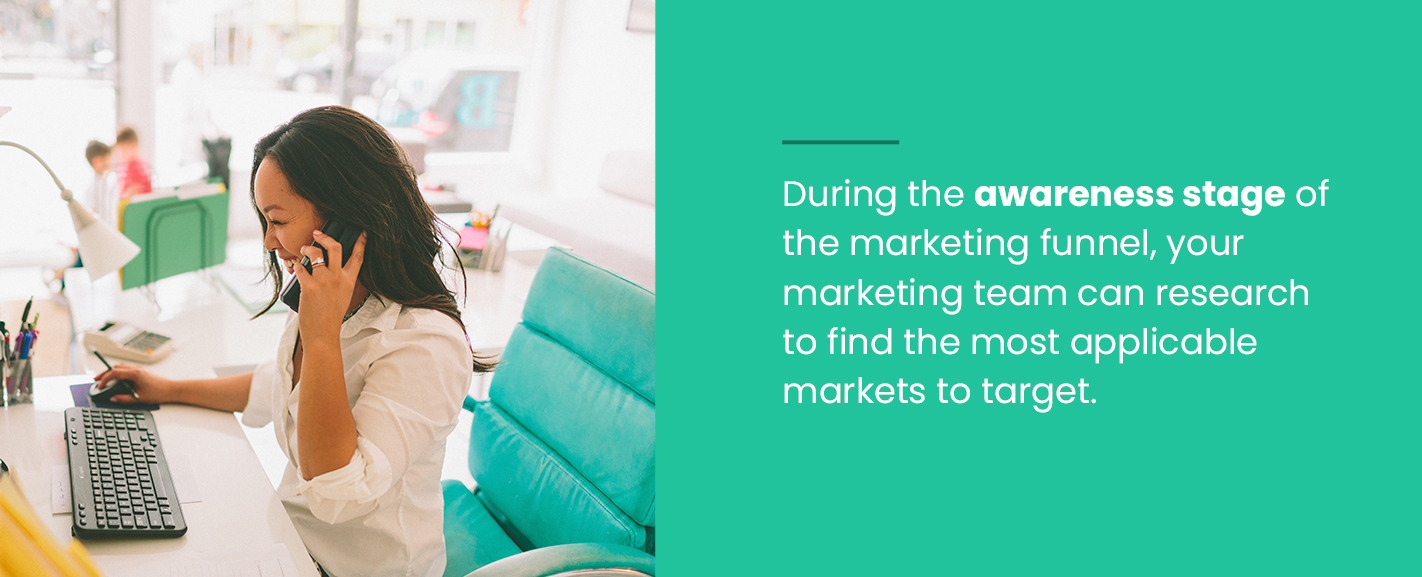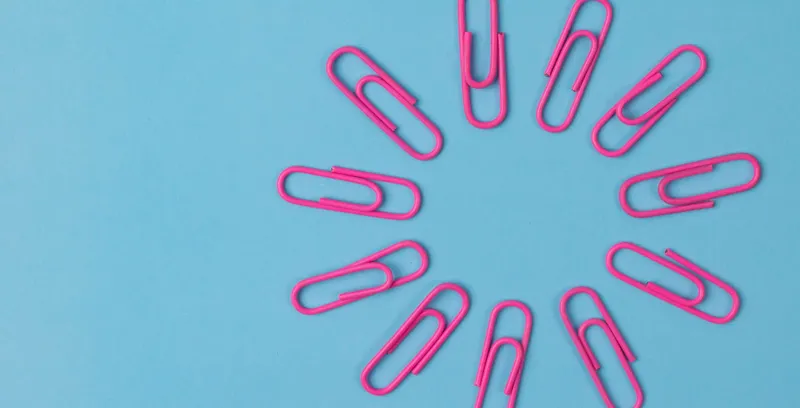While all sales funnels follow the same basic structure, consumer behavior varies depending on whether your company is business-to-business (B2B) or business-to-customer (B2C). Understanding your B2B sales funnel and its effectiveness gives your business a competitive advantage by providing insight into optimizing the sales process and converting more leads.
[Editor's note: this post was originally published in 2019 but has been updated for 2022]
Below, we'll explain what exactly B2B sales funnels are, the benefits of sales funnels, and how you can leverage your B2B sales funnel and the buyer's journey to gain revenue.
What is a sales funnel?
A B2B sales funnel is crucial to understanding the sales process from your company's point of view. While the buyer's journey captures how buyers move through the process from their point of view, the sales funnel gives businesses critical insight into how to market to particular consumers at each point of the sales process.
Going from the top to the bottom of the funnel, the B2B sales pipeline stages are:
- Awareness
- Interest
- Consideration
- Intent
- Evaluation
- Purchase
Classic sales funnel
The sales funnel has been a cornerstone of the sales and marketing strategy for over a century. It's a sequence of stages/phases in a single selling process. Elias St. Elmo Lewis invented it in 1898, making it widely regarded as the first formal theory of marketing. Ever since the humble sales funnel has been subjected to numerous revisions.
Marketing versus sales funnel
There's huge confusion in the difference between a marketing funnel and a sales funnel. Many people think marketing and sales funnels are two separate entities. There is only one funnel that marketing and sales share. However, the two teams are positioned differently. Marketing is focused more on the top of the funnel, whereas sales teams are focused mainly on the bottom.
Then why do we have two names for the same thing? Because the context of use is different. When the funnel is used in a marketing environment, it's called the marketing funnel. When it's used in a sales environment, it's called a sales funnel.
In other words, marketing builds interest, and the bottom of its funnel marks the top of the sales funnel. Consequently, marketing activities that generate awareness to create product demand power the sales funnel.
The marketing funnel is divided into two sections:
- Lead generation: This involves the creation of marketing campaigns to build brand awareness. Trade shows, inbound marketing, content marketing, viral campaigns, online ads, direct email, whitepaper, and more are used to sell the brand.
- Lead nurturing: Once a prospect develops an interest in the brand, the next step is to facilitate the lead. The potential customer is introduced to the product or service with tailored sales content to help them consider making a purchase.
Continued interest eventually tips the lead into the sales funnel, where the sales team takes over. The sales funnel brings the lead (i.e., the MQL) from the takeover point from marketing up until the moment the sale is made.
There is a heated debate in the marketing and sales worlds over who exactly owns the whole funnel. As consumers have become more dependent on digital content to inform their purchasing decisions, marketers have taken on more responsibility for the funnel in the last few years. Review the diagram below to see how ownership of the funnel has changed.
However, some see the funnel split equally, with both sales and marketing ultimately owning the funnel. They argue that the salespeople are increasingly becoming thought leaders to drive awareness by doing sales outreach. That means marketing and sales would work together to nurture leads and prospects from awareness to purchase.
If you want more tips on how to align sales and marketing, listen to this podcast episode with Bill Macaitis, former CMO of Slack, Salesforce, and Zendesk:
What's the difference between a B2C and B2B sales funnel?
Both the B2C and B2B sales funnels share the awareness, consideration, and purchase stages. However, the sales funnels look different because of different customer intent. While B2B buyers buy products and services on behalf of their company, B2C buyers purchase products for themselves, friends, or family. B2B buyers contemplate products for a long time to determine which best solves a particular business need. On the other hand, consumers who purchase products for personal use may impulsively and independently make the decision to buy.
Because of different intent, the top of the B2B sales funnel is much narrower than for B2C businesses. Marketing departments must accurately target audiences by studying B2B sales funnel metrics, while B2C marketing is much more broad-based. Further, the sales cycle is much shorter for B2C companies compared to B2B.
Here are the differences between the two sales funnels at each stage:
- Awareness: Consumers and businesses in both B2C and B2B sales funnels behave the same way during the awareness stage, as they're both searching for more information about a company's products or services. This is the broadest stage of the sales funnel.
- Interest: While B2B buyers tend to compare reviews and different products, B2C consumers tend to research the products that interest them after gaining awareness.
- Consideration: B2B buyers communicate with company stakeholders by sharing different products and reviews during the consideration phase. B2C buyers at this stage are now comparing reviews and multiple product options.
- Intent: At this stage, B2C buyers further learn about products with positive reviews and those that seem to fit their purposes best. On the other hand, this is typically the stage when B2B customers try out product demos to see how products can work with their business.
- Evaluation: During the evaluation stage, B2C consumers review their shopping cart and decide to make a purchase, while B2B buyers review contract proposals to determine which product or service is best for them.
- Purchase: Finally, this narrowest part of the funnel is when the sales transaction is complete for both B2B and B2C consumers.

Five benefits of using a sales funnel
The B2B sales funnel is a great sales and marketing tool to help you visualize, easily understand, and track the key steps involved in turning a total stranger into a paying customer. It provides visibility into the effectiveness of your sales and marketing efforts.
Benefits of using a sales funnel include:
- Attract the right leads: The marketing funnel can help you focus on the right leads for your business. During the awareness and interest stages of the marketing funnel, your marketing team can research to find the most applicable markets to target. You can survey potential leads at the top of the marketing funnel to better understand your target demographics.
- Focus on engagement: Once you've attracted the attention of the right leads, you need to nurture the lead. Sales funnels focus on engaging with leads, which builds trust in your company. Consider using video chat to engage with leads. Having a face-to-face conversation adds a personalized touch to the sales process, allows for a live demonstration, and lets the lead ask questions.
- Understand sales data: A sales funnel can help you target specific parts of the sales process you can improve. You'll be able to identify how you can better solve your customers' problems. By best catering to customer intent, you'll have an advantage over competitors by attracting and maintaining a loyal customer base. Further, B2B sales funnel metrics can help you sort your leads and rank them based on priority.
- Increase lead conversion rate: Optimizing the sales process by analyzing sales data will increase your lead conversion rate, as you’ll better understand the customer experience. Use demographic research and CRO tools to personalize the sales experience for each customer. By speaking directly to their needs at a particular time, you're more likely to convert leads.
- Increased revenue: The ultimate goal of using a sales funnel is to maximize revenue. You'll be able to track every aspect of the sales process to know which products or services sell best to which clients and how to best market to your target markets.
How to create or improve your sales funnel
Because B2B sales funnel conversion rates are much higher than those expecting leads to convert on their own, you should implement, monitor, and maintain a sales funnel to attract and nurture leads.
Consider the following when building the steps of your sales funnel:
- Awareness: Try to reach out to customers before they even realize they need your product or service. Conduct market research to identify which demographics to target and discover how current customers use your website. You should build trust during the early stages of the sales funnel so customers know they can turn to your company if they have any questions or if problems arise. Analyze your existing leads to understand how you can best reach out to new customers and nurture current leads.
- Interest: After customers know how your product or service can help fill a need they have, they are a potential lead. To maintain that lead, you'll have to nurture that lead by providing the customer with more information. Content marketing can help nurture leads by sending your customers information they find interesting and valuable while keeping your brand at the forefront of their minds.
- Consideration: During the consideration stage, businesses evaluate different products and their reviews. You should make their first contact with your business worthwhile, as many clients now come into the sales funnel at later stages.
- Engagement and intent: Continue your company's first solid impression throughout the engagement stage by providing B2B demos. At this stage, you're proving your value to the customer. While you might assume customers at this stage are sure to convert, most still need encouragement and guidance. Ensure you understand how your solution can solve specific client problems, anticipate and answer client questions, and keep in contact with leads.
- Purchase: Even after a lead converts, you should still maintain a relationship with that customer by reaching out regularly. After they buy, keeping in contact with clients builds your company's relationship with clients while driving new leads through customer referrals. Following up with satisfied customers is also a great way to gain testimonials for your website.
After you've built your sales funnel, you should work to assess and improve your current model regularly. Keep the following guidelines in mind when analyzing your existing sales funnel:
- Create customer profiles: Ideal customer profiles (ICPs) are based on real customer demographic information and your ideal customer to define which buyers are most valuable. B2B sales funnel metrics such as conversion and retention rates can help you identify which customers you should most strongly focus on. Creating and redefining ICPs can assist in aligning marketing and sales to target the right customers successfully.
- Define customer acquisition costs: Customer acquisition costs (CACs) are an essential B2B sales funnel metrics. You should have a specific process for measuring and assessing how much it costs to acquire a new customer, such as costs associated with marketing, outreach, free trials, and onboarding. Measure CACs against customer lifetime values to assess the resources you're using to convert leads and how to optimize the process.
- Coordinate marketing and sales: As we previously discussed, marketing and sales funnels overlap. Therefore, your company should align its marketing and sales effort to target ideal leads. Once leads convert, you can continue building and managing customer relationships through valuable content marketing, which demonstrates you're a reputable expert in your field.
- Evaluate your funnel: You should remember to evaluate your sales funnel to identify bottlenecks and optimize the sales process. Analyze both sales and marketing teams' performance to discover how to attract new leads while maintaining customer loyalty. You should consider factors like your brand's reputation, how your company compares to competitors, and how fast you're moving leads through the funnel at each step.
-
Scale your systems with growth: As your responsibilities and team expand, your time management tools and strategies should evolve. Regularly assess the capabilities of your task tracker against the growing demands of your organization. Incorporating advanced features, like automation and integrations with other platforms, can enhance efficiency as you scale. Embrace new features that align with your evolving needs, ensuring that no task is left unattended, and every team member remains productive.
- Grow your funnel with your business: After assessing its effectiveness, you might discover your funnel needs to evolve. As your company grows, you should scale your B2B sales funnel alongside it. Identify new markets and your expanded products and services to assess how leads are engaging with your business at each step of the funnel. For example, consider automation in the sales process to focus on the most crucial leads and gaps in the sales funnel.
Why do we need to update how we think about sales funnels
The classic five-stage sales funnel model has been around for about 125 years. Most people claim that while the main phases of this approach are still relevant, the model is outdated overall. Is it really so?
Yes, it's true that the days of the linear sales funnel where everybody enters the sales process at the top of the funnel and follows a similar buyer experience are gone for most B2B industries.
Buyers are in control
Why? Because the B2B customer has changed. Today's customers go through a complex journey when they want to buy something. Unlike generations before them, they have thousands of results, reviews, and websites at their fingertips in seconds.
In today's marketplace, it's no longer your sales team that's in control — the buyer is. As the access to information has increased, customers conduct their own digital research to inform them about products. They prefer to do all the research with little to no interference from the salesperson. In fact, Gartner reports that B2B customers are traversing 57% of the funnel on their own before encountering a sales rep, entering the sales funnel at later stages.
The buyer's journey might not follow the sales funnel
Some people eagerly announced the death of the sales funnel, offering to replace it with the buyer's journey. Although these concepts are closely linked, they aren't an alternative to each other. While the buyer's journey maps out how close a buyer is to buy from the consumer's perspective, the sales funnel takes your company's perspective to understand the buyer's relationship with the company to best sell to them at any particular stage.
The buyer's journey is a detailed outline of every step a lead takes to become a paying customer, while the sales funnel is a model that businesses use to sell appropriately to leads at different stages. If you want to bring together your content marketing and sales efforts, you have to overlap your sales funnel and buyer's journey map and look at the buyer experience from a combined perspective.
The buyer's journey is increasingly complex and non-linear
As Sales Management Association concluded, how customers move along the sales funnel has changed. It used to be unidirectional, a direct path from the top to the bottom. Now, it's multi-directional.
Leads are coming into the funnel at various points in their buyer's journey. Sometimes, this happens because existing customers refer them. If they already know they want to buy your solution, they jump in at the intent stage to negotiate the price. It also might happen because they have pursued their own research and made product/service comparisons with different solution providers, jumping in at interest or consideration stages.
To make things more complex, where buyers enter the sales funnel might not indicate where they are at in their buyer journey. Just because a buyer requested pricing information doesn't mean they are in the negotiation phase of their buying journey. Conversely, a buyer that downloads a whitepaper might be further down the funnel than their action indicates.
So when you think about all these complex and non-linear moves, the sales funnel does not seem like a funnel anymore. It looks like a complex web of individual buyer paths intersecting at the various sales and marketing touchpoints.
For that reason, some experts claim that the sales funnel is no longer relevant and must be replaced with something else. However, just because buyers have a more complex journey than before doesn't mean the sales funnel is useless. First of all, keep in mind that the sales funnel looks at things from the seller's perspective, not the buyer's. And although the buyers can enter and exit the funnel at different stages in a non-linear fashion, the funnel still helps sales organizations simplify things.
The best thing to do is align the buyer's journey with your sales process and the sales funnel.
Take the next steps in optimizing your B2B sales funnel
We've discovered how understanding your sales funnel can help you drive and nurture leads by recognizing consumer behavior differences in B2C and B2B sales funnels. You know a sales funnel enables you to engage and convert leads. Now that you've implemented a sales funnel in your business, you can identify where you can improve the sales process.





